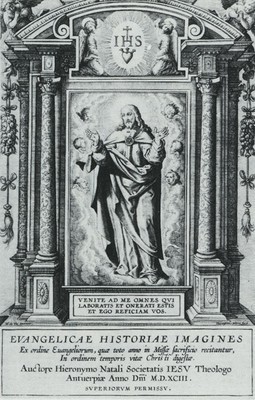Gallery 1: The Evangelicae Historiae Imagines
Abstract
It was Saint Ignatius of Loyola, the founder of the Jesuit order, that approached Father Jerome Nadal (1507-1580) and asked him to design a book that presented episodes of the Gospels with pictures, explanatory texts, and pious meditiations (Kelemen 1951, 201). Father Nadal obliged, designing the Evangelicae Historiae Imagines (or Images of Gospel History).
Published posthumously in Antwerp in 1593 at the Plantin-Moretus publishing house, the Evangelicae Historiae Imagines became a monument of Flemish printing in the 16th century. It contains one hundred fifty-three engravings preceded by a frontispiece, which was also engraved. The "inventors" of these images were Gian Battista Fiammeri, Bernardo de Passeri, and Maarten de Vos; its engravers proper were Anton, Hieronymus, and Jan Wierix, as well as Charles Mallery, and Jan Collaert (Mesa and Gisbert 1982, I, 103).
The Evangelicae Historiae Imagines was one of the most important sources of Spanish Colonial Art. It traveled throughout the Spanish Empire serving as a book of models for indigenous artists (Fiocco 1987, 3). See for example Mesa and Gisbert 1982, I, 105f.
You can sample the impact of the Evangelicae Historiae Imagines in this gallery. Here we display woodcut versions of the mysteries of the rosary done in China ca.1620. The woodcuts were done by an anonymous engraver of the Late Ming Dynasty, and serve as illustrations to Song Nianzhu Guicheng (Method of Reciting the Rosary), a book published by Father João da Rocha, S.J. in Nanjing.
To visit this gallery, simply follow the navigation panel below throughout this website. Clicking on the down arrows will take you through the gallery; clicking on the up arrows will allow you to retrace your steps.


